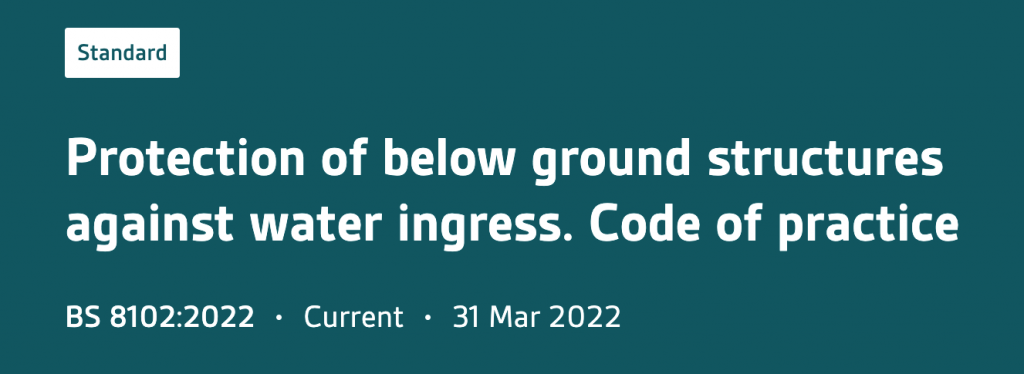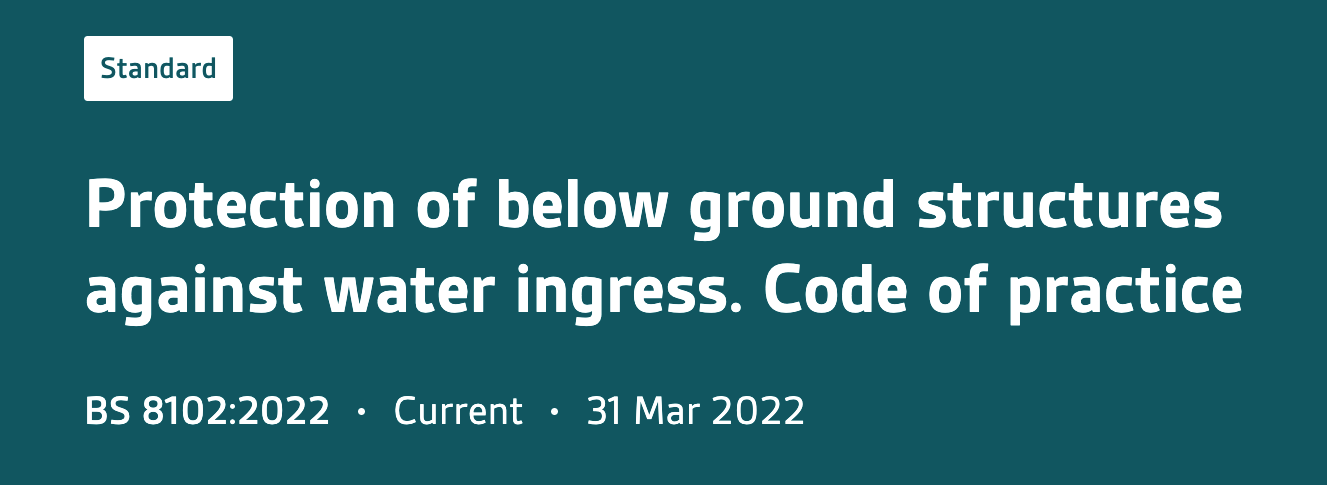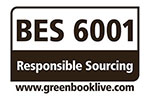01732 496 523
What is the New British Standard 8102:2022?
The New British Standard 8102:2022 is the ‘Code of Practice for Protection of Below Ground Structures Against Water Ingress’. This is the latest revision of the standard.
The standard takes the form of recommendations and guidance, and the execution of its recommendations should be entrusted to appropriately qualified and experienced people.

Updates to the Standard
On March 31st 2022, the new British Standard for waterproofing was released, providing everyone with access to the updated version of the Standard, BS 8102:2022.
The newly titled standard includes a wide number of revisions and updates to the previous 2009 version.
New updates to the standard will have a significant impact on the industry as a whole, which is why at Newton Waterproofing, we’ve written a technical paper to provide a section-by-section overview of the most important updates.
In order to help with educating construction professionals on the most important updates to the standard, we’ve also created a new RIBA approved double points core curriculum CPD on ‘Waterproofing Design Strategies to the New British Standard 8102:2022’.
The new seminar directly replaces the previous version focusing on BS 8102:2009, which was our most popular CPD with architects, surveyors, designers and contractors alike, and consists of a 45-minute seminar plus a Q&A. The CPD can be delivered either at your office, as an online webinar, or at our training facility in Tonbridge, Kent.
What are the Updates to the New British Standard?
Below is a summary of the technical paper we’ve created, giving a section-by-section overview of the most important updates.
Read the full technical paper here.
Scope
The new standard now makes reference to other factors that can be associated with the design of below ground structures, such as ground gases and flooding.
It also adds clarification on potential end uses for structures that are partially or wholly below ground, the most common materials used for retaining structures, and well-recognised terms for certain building elements.
Normative References
This section has been generally updated to reflect the status of the most relevant recognised standards.
Previous references to material specification standards for damp proof courses and bitumen or mastic asphalt products have been removed in favour of a more detailed commentary.
There are also some new reference standards introduced concerning the execution of concrete structures.
Terms and Definitions
Several existing references have been the cause of some debate within the industry in previous years, so this revision has provided clarity within the general context of the standard.
Some new references have been included, including “buried decks” and “ground gas barriers”.
Further new references are included in a technical context, such as “fully bonded” and “water resisting admixture” to reflect their common usage in the industry, and to cover similarly used hydrological terms such as “hydrostatic pressure”.
The terms “ground barrier” and “vapour check” have both been removed in favour of more detailed technical references, which have been included either in this section or elsewhere in the standard.
Design Philosophy
Added emphasis has been given to the importance and scope of the waterproofing designer role, and the standard now recommends that a waterproofing design specialist should be consulted at the earliest stage of a project.
This is ideally before the technical design stage, and the specialist should be consulted and approve of any amendments which may impact on the overall waterproofing design.
Site Evaluation
There has been a simplification to the primary and secondary research recommendations, with the aim of ensuring that all studies are related to the relevant Eurocodes.
The minimal steps that are recommended to be undertaken as part of the site evaluation include a desk study and a risk assessment that includes the potential effects of climate change, along with a water table classification, inclusion of ground gas contaminants, and other external risks.
Water-Resisting design
This section includes perhaps some of the most notable changes in the 2022 version of the British Standard:
- Groundwater – Measures to resist water for a below-ground structure should be considered for any part of the structure that is below the DPC level. There is also a new recommendation that the waterproofing design specialist, as part of the design team, agrees on the potential head of water that may come to bear against the retaining structure, as based on the site evaluation and risk assessment.
- General waterproofing protection – There are now many more considerations that need to be taken into account when selecting and specifying a choice of waterproofing system. These include the need for combined protection, the water table classification and required performance grade, and the need for continuity in the protection, amongst others.
- Waterproofing design for existing structures – This section now includes considerations that should be made by the design team regarding the effects of a waterproofing design on existing structures. The team should therefore take into account the impact on floatation forces, and the impact on the existing structure on matters such as embedded timbers and moisture balance.
Other revisions in this section include changes to significant sections of the Standard regarding combined protection, continuity of waterproofing protection, external sub-surface drainage, buried decks below ground level, and ground gases.
General Construction Issues
Revisions within this section include to the recommendations surrounding:
- Site dewatering
- Unexpected hazards
- Structural elements
- Continuity in construction
- Protecting waterproofing
Type A (Barrier) Protection
Revisions within this section include subjects such as:
- General structural aspects
- Differential movement and cracking
- Continuity of waterproofing barrier
- Structural penetration and loading through waterproofing barriers
- Movement joints
- General waterproofing barrier materials
- Cementitious crystallization slurries and powders
- Cementitious multi-coat renders, mortars and coatings
Type B (Structurally Integral) Protection
Revisions within this section include to recommendations on:
- Materials for structurally integral protection
- Concrete containing waterproofing admixtures
- Waterstops
Type C (Drained) Protection
Cavity drain waterproofing is perhaps one of the most commonly used waterproofing methods, so it was important that this section was updated to ensure that modern Type C systems are designed and used correctly.
The updates include a focus on the use of the systems in multi-level basement projects, and on the continuity of waterproofing systems.
Furthermore, it emphasises that the waterproofing designer responsible for the design must ensure that it complies with all requirements and uses of the structure.
Two more important additions are also with regards to the specific details on pumping systems and their discharge options, as well as the importance of pump system maintenance, repair, commissioning and future servicing.
Revisions within this section include:
- Structural aspects
- Leachates and free lime
- Drainage design
- Multi-level systems
- Cavity ventilation
- Inverted cavity drain systems
- Discharge systems
- Pumps
- Servicing and maintenance
Remedial Measures
Revisions within this section include:
- External grouting or injection
- Repair with cementitious or polymeric systems
- Masonry structures
Overall, the updated version of BS 8102 has brought the Standard in line with modern-day waterproofing best practice, as well as recognising the many recent technological developments and innovations in the industry. Perhaps most important however, is that no individual statement or recommendation within BS 8102:2022 is considered in isolation, but as one element of the many interlinked sections that make up the whole document.
To learn more about the new British Standard please get in touch with the Newton Waterproofing Technical Team on tech@newtonwaterproofing.co.uk. Alternatively, to book any of our RIBA Approved seminars, email us directly at training@newtonwaterproofing.co.uk.
Two more important additions are also with regards to the specific details on pumping systems and their discharge options, as well as the importance of system maintenance, repair, commissioning and future servicing.
Revisions within this section include:
- Structural aspects
- Leachates and free lime
- Drainage design
- Multi-level systems
- Cavity ventilation
- Inverted cavity drain systems
- Discharge systems
- Pumps
- Servicing and maintenance
Remedial measures
Revisions within this section include:
- External grouting or injection
- Repair with cementitious or polymeric systems
- Masonry structures
To learn more about the new British Standard or to book any of our RIBA Approved seminars, email us directly at training@newtonwaterproofing.co.uk.
Speak to our friendly, expert team
Our staff are able to provide guidance for projects of all sizes, whether you require some general advice about damp or waterproofing, or support with technical drawings and specifications.














